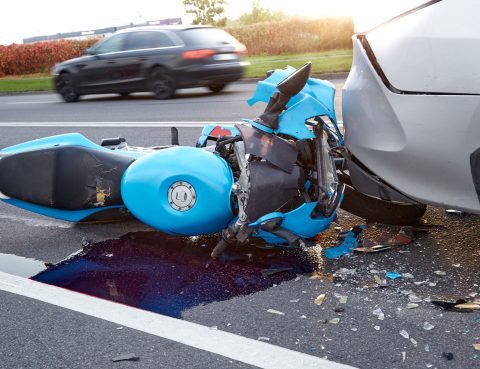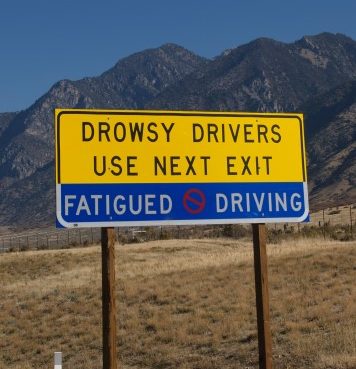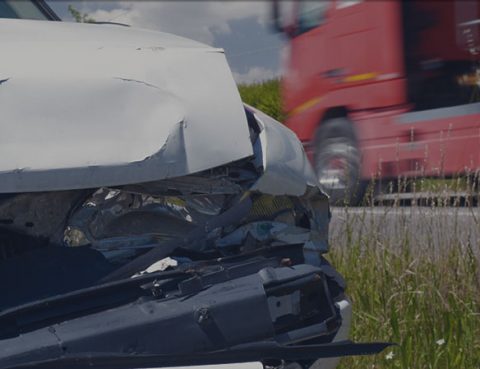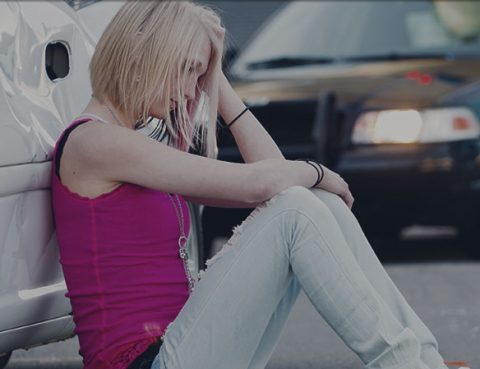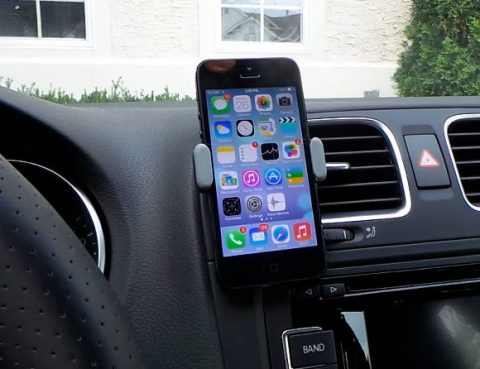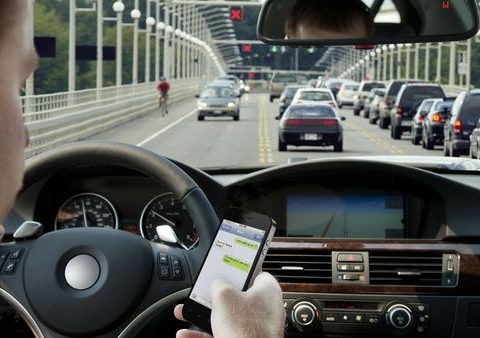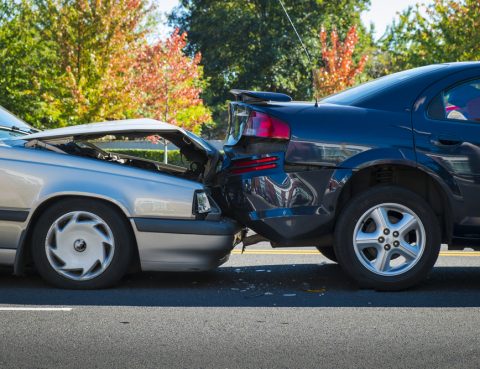18-Wheeler Stopped in Middle of Road
Motorcycle accidents are inherently more dangerous than normal car crashes due to the lack of protection a motorcycle can give, though motorcyclists as a group are generally very safe. However, distracted driving due to lack of sleep can impair any motor vehicle operator. This puts the lives of others at risk.
On the evening of Wednesday, February 8th, Deputy Jennifer Olvera responded to a scene on FM 517 in Galveston. A large commercial truck collided with a motorcycle, and the motorcyclist was unresponsive. According to witnesses, the motorcyclist applied his brakes to avoid hitting the semi-truck and was thrown violently from his motorcycle. There is no confirmed cause of the accident, but there is speculation that the driver of the truck was tired.
Upon finding the motorcyclist, Deputy Olvera immediately began chest compressions. The motorcyclist was helicoptered to a hospital, and as of this writing he is in critical condition.
Deputy Olvera was not working that night, but is being praised as a hero for helping save the man’s life.
Motorcyclists can claim compensation in court
If you or a family member are in a motorcycle crash where it seems that the other driver may not have been awake or even admits to being tired or asleep, it’s a good idea to speak with an attorney with experience in motor vehicle accidents. Insurance may not cover the complete replacement of the vehicle nor possibly all the medical expense. This is to say nothing of copays, lost time at work and ongoing treatment. Compensation from the other driver may not make the injuries go away nor properly fix the damage, but it can help accident victims and their families bounce back after such cataclysmic events like an car crash.
Source: khou.com, “Galveston Co. deputy helps saves man’s life after crash“, February 16, 2017
Drowsy Drivers up to 12x Accident Prone
A recent announcement of findings by the AAA Foundation for Traffic Safety says drivers aren’t getting enough sleep. No surprise really. We’ve all been there — whether it’s commuting to work after a sleepless night with a sick child, or burning the midnight oil to meet a school or work deadline.
The AAA’s findings are supported by the Centers of Disease Control and Prevention, which says one in three people in the U.S. sleep less than the recommended amount. The AAA also pointed out in their announcement that one in five fatal crashes involve lack of sleep.
The announcement heralds a 19-page report entitled “Acute Sleep Deprivation and Risk of Motor Vehicle Crash Involvement,” which also breaks down the increased likelihood of a crash by the number of hours of missed sleep.
The statistics in it are not pretty:
- 6-7 hours per night is 1.3 times more likely to crash.
- 5-6 hours per night is 1.9 times more likely to crash.
- 4-5 hours per night is 4.3 times more likely to crash.
- Less than four hours is 11.5 times more likely to crash.
It should be pointed out that four to five hours of sleep is the equivalent of driving with blood alcohol level of .08 or above, which means you are essentially a drunk driver.
There are, however, strategies that drivers can take to increase their odds for safe driving. The obvious place to start is to get at least seven hours of sleep each night.
There are other tips for drivers as well:
- Don’t drive during the hours when you normally sleep.
- Schedule a break every two hours or 100 miles.
- Avoid medications that cause drowsiness.
- Don’t eat large meals and then get behind the wheel.
- Travel with alert passengers and share the driving on trips.
The good news in this is that drivers can choose to take the above precautions. While nothing is guaranteed, drivers are looking for trouble if they don’t sleep and don’t take a sensible approach to driving.
If you or a family member are in a vehicle crash where it seems that the other driver may not have been awake or even admits to being tired or asleep, it’s a good idea to speak with an attorney with experience in motor vehicle accidents. Insurance may not cover the complete replacement of the vehicle nor possibly all the medical expense, to say nothing of copays, lost time at work and ongoing treatment. Compensation from the other driver may not make the injuries go away, nor properly fix the damage, but it can help accident victims and their families bounce back after such cataclysmic events like an car crash.
Prescription Drug Effects on Driving
The word “epidemic” has been used repeatedly by news sources for the prescription drug addiction problem in America. Millions of Americans are addicted to drugs that they can simply get from their neighborhood doctor. Opioids, or pain killers, are the most addictive. The rate of sales of prescription pain killers has quadrupled from 1999 to 2010. It is common for people to “doctor shop,” or visit multiple doctors to get more than one prescription. 259 million prescriptions were written for painkillers in 2012. That means that every adult in America could have had their own bottle of pills.
Prescription drugs can cause similar effects as alcohol
Most of these drugs do not mix well with driving. Little warning labels are printed on the side of the bottles, stating “do not operate a vehicle while taking this medication.” Sedatives such as Valium cause impairment similar to being drunk. High doses of painkillers can impair drivers with drowsiness and a slowed reaction time. With the prevalence of prescription drug addiction it is scary to picture how many people actually drive while on drugs.
According to the 2014 National Survey on Drug Use and Health, 10 million people reported driving under the influence of drugs. Studies have shown that 11 percent of deadly car crashes involve a drugged driver. 47 percent of drugged drivers who are involved in those accidents tested positive for a prescription drug. These drivers are negligent and do not consider the danger that they pose to everyone on the road. Drugged drivers often lead to car accidents which can injure and cause fatalities. Victims and their families must often seek personal injury lawsuits against drugged drivers to recover some compensation for their altered lives.
How can people prevent drugged driving?
It can be difficult to prevent others from driving while under the influence of drugs, but there are steps that people can take to help. Improvement starts at home, so offer to help those around you. People are usually secretive about their prescription drug use. Asking questions and being aware can keep you in the loop. If you know of a friend or family member who abuses medication then you can do the following:
- Ask them how they will get home
- Offer to be their designated driver
- Take their car keys if they are visibly impaired
- Keep an open conversation about the dangers of drugged driving
Stay Safe During the Holidays!
Like most people this holiday season, you will likely be travelling to visit relatives. You are thinking about how excited the kids will be for their presents or what you will bring to the dinner table. While you are on your way to see family members you should also keep in mind another thing: safety on the roads. This time of year is especially dangerous for drivers.
Eat, drink and be merry, but don’t drive
Cocktails and Champagne go hand in hand with Christmas and New Year’s Eve. When the party ends a high number of people decide to drink and drive. In fact drunk drivers are the cause of 40 percent of traffic crash deaths over the two holidays, a 12 percent increase over the rest of the month. The worst thing imaginable would be to lose a loved one during a time meant for family.
An average of 300 people die in accidents in the U.S. every year during the days surrounding Christmas and New Year’s. The families of these victims must deal with the heartache that follows. Many families seek compensation through wrongful death lawsuits in these cases. Although compensation will not bring back their loved ones, it is important to hold negligent drivers accountable for their actions.
Plan ahead to stay safe this season
During the holiday celebrations it will be hard to avoid a drink or two. If you drink then find a safe ride home with a sober driver or a cab. If you absolutely must drink and drive then know that there are no ways to speed up sobriety. Coffee or exercise might fend off drowsiness for a little while, but your reaction time will still be delayed. Play it safe and find a ride this holiday.
Could New Regulations Affect Cell Phones in Cars?
Traffic fatalities have been on an encouraging downward trend over the past forty years. It wasn’t until 2015 when we saw the largest spike in traffic deaths in four decades. The possibility of a fluke was ruled out as data shows that this year is looking even worse. Traffic safety analysts have their fingers pointed at the biggest culprit: distracted driving. In reaction to these findings the National Highway Traffic Safety Administration is urging phone makers to crack down on the problem.
Feds suggest blocking features while a vehicle is moving
Federal safety officials are concerned about the number of people who are using their smartphones while driving. The average commuter could agree that it is easy to spot people driving while their eyes are locked down on their phones. Recently the National Highway Traffic Safety Administration (NHTSA) has released a statement asking smartphone makers to block distracting features in moving vehicles. The proposal highlights a suggested mode which would block videos, texting, and many apps while the user is driving.
The proposal was met with immediate opposition from phone makers. Apple and Samsung said the suggestion is an extreme reaction to the problem. They highlighted that it would block the future invention of technology which could help users make better decisions while driving. Phone makers do no need to comply with the NHTA because their legal authority does not control device makers, only vehicle makers.
Distracted driving deaths are on the rise
Unfortunately there is no doubt that distracted driving is on the rise. Last year resulted in an 8.8 percent increase in distraction-related crash deaths. This means that 10 percent of fatalities in car accidents are due to a distracted driver. Yet federal traffic safety analysts fear that these numbers are much lower than the reality of the situation. The statistics might be off because most police officers do not currently check phone usage during the time of an accident.
The rise in distracted driving has not only NHTSA concerned but the Department of Transportation. This past October the Department of Transportation stated that they will be working with the National Safety Council with the goal to eliminate all roadway fatalities within 30 years. The initiative is called “Road to Zero.”
While the goal seems lofty, the Department of Transportation believes that it is achievable through improving seat belt usage, enforcing truck safety, installing more rumble strips, and focusing on changing driver behavior. Also the introduction of automated vehicles appears to be a light on the horizon for increasing safety through new technology.
Could New Regulations Affect Cell Phones in Cars?
Texas remains one of only four states that do not ban texting while driving, along with Arizona, Montana and Missouri. Last month, Rep. Tom Craddick, R-Midland, and Sen. Judith Zaffirini, D-Laredo, introduced bills for consideration in the upcoming legislative session that begins in January that would make texting while driving a crime.
This is the fourth time Rep. Craddick has introduced such a bill. In the last legislature, a similar measure failed in the state senate by only one vote, and in the session before that, Gov. Rick Perry vetoed one.
Some Texas cities ban the practice
We last discussed distracted driving this summer, when we reported that despite no state-wide ban, more than 60 Texas municipalities at that time banned the practice by city ordinance. Now, that number has risen to more than 90 Texas cities that prohibit texting while driving within their boundaries, according to the Texas Department of Transportation website.
Cities in the Lone Star State with texting-while-driving ordinances include Galveston, Angleton, Brazoria, Richwood, Missouri City, Bellaire, Deer Park, Shoreacres, Tomball, West University Place, McAllen, Mission, Harlingen, Austin, Brownsville, Corpus Christi, El Paso, Laredo, Midland and San Antonio.
Texting is a driving distraction
Texting while driving is obviously a public safety issue and a statewide ban has the potential to save lives. Texting while driving is a type of distracted driving, meaning anything that takes the driver’s eyes off the road, hands off the wheel or concentration off the task of driving. Texas DOT says that more than 100,000 crashes annually in the Lone Star State involve some kind of distracted driving.
Two sobering federal data points are often cited in the media. The Federal Motor Carrier Safety Administration or FMCSA reports that texting while driving increases the chance by 23 times of a “safety-critical event.” In addition, when a driver takes his or her eyes off the road for 5 seconds to text, at 55 mph, the vehicle moves the length of a football field without the driver looking at the road.
Current restrictions on cell phones behind the wheel
Current laws do restrict some cell phone use by drivers in Texas. For example, federal law prohibits commercial drivers from using cell phones, including texting, while driving. State law provisions include:
- Bus drivers with minor passengers on board may not use cell phones in any way, including texting, unless they are stopped or in emergencies.
- Drivers under 18 may not use cell phones in any way, including texting, except in emergencies.
- With narrow exception, drivers may not use cell phones in any way, including texting, in school zones.
The proposed bill
The bill would make reading, writing or sending a message on a mobile phone while driving a crime, unless the car is stopped first, an “illegal activity” is being reported or to request help in an emergency. An email could be read if there is a reasonable belief that it concerns an emergency. Hands-free cellular phones could be used via voice, but not for emailing or texting while driving.
Narrow exceptions exist for use in certain jobs and for law enforcement and emergency vehicles.
Anyone found to have violated the texting ban would be subject to relatively minor fines and the violation would not result in points being added to the driver’s license. Still, however, a conviction for texting while driving would likely be relevant in a civil lawsuit for injuries caused by an accident that occurred while the driver texted.
Advocates for those injured in motor vehicle accidents will watch the progress of these bills with interest. In the meantime, anyone injured in a motor vehicle accident should speak with an attorney about potential legal remedies like a personal injury lawsuit. If the other driver was texting while driving, legal questions arise like whether he or she was driving negligently, recklessly or in violation of a city ordinance, and the answers may have impact on liability in a civil lawsuit.
Deer & Animal Road Obstacles can be Deadly
The holidays are coming soon, but first, there’s deer-crash season. November has earned the dubious national distinction of having the most car accidents with deer, and Texas is no exception. When they’re running across the road to seek (or perhaps avoid) a mate during rutting season, deer don’t know to “look both ways” and often dart out right in front of traffic.
With only seconds to respond, drivers may panic. Distracted drivers may not notice until it’s too late. Impaired drivers may be confused by what’s happening. In any scenario, there are multiple risks, sometimes involving more than one car.
So how can you prevent a crash?
Some tried-and-true tips recommended by the American Automobile Association (AAA) and others are based on common sense:
- Be vigilant when driving at dawn or dusk; and at night, use your high-beam headlights when you can. You’ll see the road more clearly.
- Continuously scan the road and side shoulders ahead of you for approaching animals during these same times of day. (At the same time, keep your eyes on what’s right in front of you as well.)
- If you see one deer, wait for it to cross and then look for others. They will travel together at times.
What if the deer loses…and the driver also loses?
If the above tactics don’t help one day and you end up heading straight for a deer when it’s too late to completely stop, mitigate the effects of the crash by staying in your lane. That’s harder than you think. Your first instinct will be to swerve, but if you do so you’re putting other drivers and passing vehicles at risk. Slow as much as possible, applying steady pressure to the brakes. You may hit and injure the deer, and you may receive injuries as well, but that’s a better outcome than running into another car-or a heavy truck-by swerving into another lane. Take a look at our info on what to do when you get into an accident.
Deer crashes can’t always be controlled
As careful as you try to be, strange chain-reaction accidents can still happen. There’s no telling how drivers around you may react and respond to a deer on the road. In short, you need to take extra care, slow down, be alert and focus on defensive driving during November as deer crossings will be plentiful. Getting to your destination a few minutes later than desired is not a big deal compared to colliding with wildlife and all the repercussions that could bring. Stay safe!
Lack of Sleep is a Cause of 18-Wheeler Accidents
On behalf of Tylka Law Firm and Mediation Center posted in Truck Accidents on Thursday, September 8, 2016.
Two factors drive independent truckers: they are paid by the load and they are paid for timely deliveries. With variables like traffic and road conditions, a drive from Galveston to Austin, scheduled for four hours, could take six. The driver, to save face, may speed or cut back on rest to stay on track.
Drowsy driving is dangerous, with reduced sensory awareness and response time that increases the risk of an accident. Collisions involving trucks often have serious consequences.
Trucker fatigue is a real problem
In 2014, the maximum hours for a driver were reduced from 82 to 70 hours per week, still far beyond the standard 40-hour workweek expected in most industries. The New York Times reports of disparate statistics involving fatigued truck drivers, but the numbers range from just 2 percent of accidents, based on official police reports, up to 13 percent in a government study. An older report by the National Transportation Safety Board, found 31 percent of truckers who died in crashes were fatigued, which showcases that a tired truck driver is a dangerous truck driver, to him or herself and to others on the road.
Statistics don’t tell the full story
The numbers in those studies underestimate because drivers, by admitting sleep deprivation, admit fault. It is difficult to prove that a driver was sleeping without an admission. In individual investigations, cell phone records and highway receipts have found differing times than a trucker’s log book. Truck drivers follow orders from their employers, and sometimes dispatchers or management seek profits over safety.
Although rules are in place to keep drivers from being overworked or skipping sleep, many logs are easy to manipulate and it becomes an honor system that a driver will take the required rest stops and be aware enough to drive his or her rig safely.
Stay Safe During Road Trips
It’s fast coming to a close–Labor Day weekend is just a few days away and many people will be heading to Galveston for some sunshine and a suntan. It’s the last long weekend of the summer, and a perfect time for a family outing. But many other people will be following your lead–and with more cars on the road, comes more possibilities for accidents.
There are a few ways to stay safe and limit the possibility of a collision. When heading out Monday morning, consider the tips below for a safe and happy journey.
Top tips for staying safe on a busy road
Being mindful of other drivers on the road is the key to a safe journey. Remember: you may be driving safely, but that doesn’t mean other drivers are. Remaining aware of your surroundings and the driving pattern of others is essential.
In addition, here are some tips to help ensure safe travel for you and your family:
• Kids in car seats: Children are precious cargo and children eight years old and under need to be in some sort of restraint system. Fines for not complying? Up to $250.00
• Buckle Up: As the driver, you set the example. Buckle up and ensure all passengers do as well. Fines for a family of four who fail to click‑it can run up to $650.00
• Go commando: With your phone that is. As soon as you put your car in drive, put the phone in your purse or glovebox. No one said you couldn’t check it at rest stops, but texting and driving is illegal. Fines can range up $500.00 And remember, this is family time! Make memories–and not ones of being pulled over by a cop. Do you really want your kids repeating that story every Christmas for the foreseeable future?
• Mind your speed: Sure everyone wants to get where they are going in a timely fashion. But speeding increases your risk of collisions. You and your family’s well-being simply aren’t worth the risk or the fines–which can run as high as $300.00
• Toast the end of your day: Save the adult beverages for your return home. Nothing says smart-parenting like waiting to have a drink after you are done driving. That cold beer is going to taste much better on your back porch–without the threat of a drunk driving arrest. Fines? Up to a princely 2K. Along with up to $2,000.00 per year just to maintain your license–after you get it back a year later. Bet you can find another use for $8,000.00
• Go early, leave late: Many people will also be heading to the beach, so beat the early birds and leave first thing in the morning–you’ll have a calmer trip, easier parking and the opportunity to snag your favorite part of the beach. Leave later and you’ll have more room to yourself on the drive home. Fine: Zero! And you’ll be rewarded with a more peaceful day.
Remember to have fun over the weekend
Summer is the time to make lasting memories with your family–before you know it, you’ll be toting your grandkids to the beach! Set a good example and stay safe. Your choices will protect your family now, and well into the future.
Tailgating Causes Hundreds of Accidents in Texas
We’ve all seen it. Someone following another driver so closely, you wonder if they are hitched to each other. It’s a dangerous scenario–for both drivers. In the event the car in front has to make a sudden stop, an accident is almost assured. And at that distance and highway speeds, neither driver is going to have a positive outcome.
We’ve all been frustrated by a driver who seems to get stuck in a lane and no matter how we try, we just cannot get around their vehicle. Whether you’re already late for an important appointment, or, like a lot of us, just plain annoyed with a slow driver, the simple truth is that letting that irritation get the best of you could result in serious damage to you–a flipped and crushed car is not something your family is eager to see. Especially if you were in it.
The Stats of Tailgating
According to the Office of Disease Prevention and Health Promotion, 80 percent of drivers admitted to aggressive driving, including “tailgating, confronting other motorists and even hitting other cars on purpose.”
The study further states that among aggressive behaviors, the top ones include:
•· Rude Gestures
•· Blocking another car from changing lanes
•· Cutting off other cars
Astoundingly, nearly 4 in 100 drivers get out of their car to confront other drivers. This kind of behavior is not just unsettling, it’s not just inconsiderate, it’s illegal. And aside from causing serious accidents that result in great bodily harm, it can also land you behind bars.
What if I am the victim?
Plain and simple, if someone makes threatening gestures, cuts you off and then slows down, or follows too closely, pull out of your lane, slow down and remove yourself from the aggressive driver. If someone follows you after you have tried to evade the situation, drive to a safe location, stay in your car and call the police. Your future and your safety are not worth someone else’s lapse in judgment.
80 percent of us have driven aggressively at one time or another–which means that you have likely been both the provoker and the provoked. The next time you find yourself in either position, take a deep breath, step back and remember: choose safety instead. It truly is a matter of life and death.


